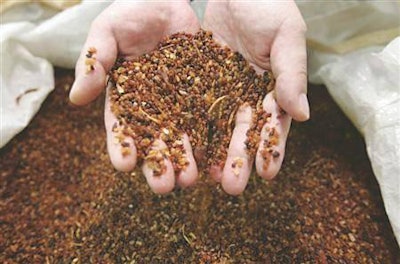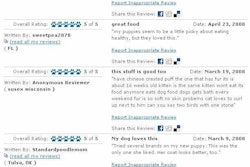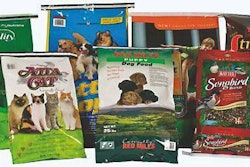
As food safety issues continue to remain a hot-button topic, it's up to petfood and treat manufacturers to start implementing procedures that ensure the safety of their products to the consumer and their pets. According to the US Centers for Disease Control (CDC), from 2006 through 2008, a total of 79 cases of Salmonella infection were linked to dry petfood. Far less costly than a recall, evaluating your current procedures now and executing new procedures and standards is the only way to protect your brand, as well as the pets consuming the product. So where should you begin?
Electronic nose analysis
According to a recent study at the Animal Nutrition Department of Veterinary Sciences and Technologies for Food Safety at the University of Milan, Italy, the increased focus and interest in pets' health and welfare make it essential that petfood complies to specifications ensuring good nutrition, as well as prevention and treatment of cat and dog diseases. There is an increasing need for new technologies and applications for existing technologies for a more comprehensive screening of petfood. A recent technique, based on the use of a technology called the electronic nose, may represent a promising analytical approach by providing quantization of quality and safety in real time with the objectivity of an instrumental response.
"An e-nose is an instrument that comprises an array of electronic chemical sensors with partial specificity and an appropriate pattern recognition system, capable of recognizing simple or complex odors," explains the study. The e-nose does not distinguish each volatile substance, but expresses the global odor of a product. Sensor array formats in the e-nose interact with different volatile molecules and provide an electronic signal that can be used effectively as a fingerprint of the volatile molecules associated with the product.
The application of the e-nose in the petfood industry can provide an interesting approach for quality control and qualitative protein source characterization, the study claims. Currently the main applications of the e-nose technology are in the food industry with the aim of monitoring freshness, onset of microbial spoilage or bioprocesses of food and determining food authenticity. "We can take what we know from the food industry and foresee future analytical challenges in the petfood industry," the study's authors say.
Fighting Salmonella
According to a recent study by the XIM Group, acidic calcium sulfate (ACS) can lower the pH of petfoods to microbial stable and antimicrobial levels. There are a number of unique challenges associated with control of Salmonella contamination of products in the petfood industry. Of primary significance is that the ingredients used for producing petfood are vulnerable to contamination with Salmonella and other microbes as they arrive at the manufacturing facility, supplying a steady stream of new microbial inoculants to the processing plant.
Broadly speaking, there are two general approaches to addressing the issue of potential recontamination of products (after the extrusion kill-step in dry petfoods). The first is to attempt to eliminate as much as possible the potential sources of Salmonella recontamination.
A second approach, which is underutilized in the industry today, according to XIM, is to implement a means of reducing or eliminating microbial populations in products that may become recontaminated. In the food industry, one method commonly used for preserving high-water activity foods is to create acidified foods by adding acids to lower the pH to less than 4.6.
Some petfoods, in particular soft-moist foods and treats, already use parts of this approach by utilizing the addition of phosphoric acid, hydrochloric acid or other acids to lower the pH. Generally it is used in combination with other ingredients added to control water activity. ACS is a new ingredient available to the petfood industry under the trade name pHresh from pHresh Technologies, Sabetha, Kansas, USA.
ACS can be used to lower the pH of petfoods to microbial stable and antimicrobial levels, and is available in a strength similar to phosphoric acid for this purpose.
A unique characteristic of ACS is that it does not have the strong sour flavor associated with other acids. Therefore, addition levels required to reach a microbially stable or antimicrobial pH will not negatively impact the palatability of most petfoods, according to the company. In fact, some indicators show that the addition of ACS to certain foods, including extruded kibble or the coating of canine diets, results in increased preference.



(1).png?auto=format%2Ccompress&fit=crop&h=167&q=70&w=250)











